Reunification Palace – where Viet Cong tanks crashed through the wrought-iron gates to end the Vietnam War – is like a time capsule from the 1960’s.
Never mind the tank near the front gates, the military gadgets frozen in time or the bomb-proof war bunker.
The real show stopper when you visit Reunification Palace in Ho Chi Minh City has got to be the soviet-era furnishings that tell a tale of style, opulence and power.
It feels as though time has stood still here since April 30, 1975, when Viet Cong tanks smashed through the palace gates, beginning the reunification of North and South Vietnam into a single nation.
Many of the kitsch 1960s furnishings that presumably belonged to South Vietnamese President Nguyen Van Thieu are still there, eerily frozen in time.
Throughout the palace – from the grand banquet hall and conference room near the foyer to the private office and residential quarters on the upper floors – it’s easy to become mesmerised by the 1960s design and decor.
With its plush rugs, lavish curtains and funky square lampshades, it’s a stunning showcase of modernist political architecture and retro design.
Even from the outside, Chinese-styled characters have been incorporated in the design of the building to bring good fortune. You can see these features in the pylons at the front of the palace.
It’s no wonder The New York Times once called it “the sexiest building in South East Asia”.
Formerly known as Independence Palace, it was renamed Reunification Palace in November 1975, and designated as a historical and cultural relic.
Today, it is the most popular tourist attraction in Ho Chi Minh City, formerly known as Saigon.
The palace was originally designed as the home of President Ngo Dinh Diem, the US-backed leader of Vietnam. But he never saw construction completed as he was assassinated in 1962.
The palace later became the command centre for President Nguyen Van Thieu, who directed South Vietnamese forces during the Vietnam War.
You feel the sense of history as soon as you enter the wrought iron palace gates, the historic location where two North Vietnamese Army tanks smashed through (below) at 10.45am on April 30, 1975.
One tank still sits proudly in the grounds today with its gun barrel pointing at the palace.
Inside the Palace
The 12-hectare grounds include the three-level, 95-room palace surrounded by lush and spacious gardens, with four tennis courts out the back and an oval lawn and fountain at the front.
The basement within the palace housed the war command room – a rabbit warren of windowless offices with large yellowing maps on the walls and various communications equipment scattered about. There was also a network of escape tunnels.
Upstairs, near the wide main lobby, is the Banqueting Hall, Conference Room and Cabinet Chamber, with offices for high-level ministers nearby.
The second floor is where you’ll find the lavish Ambassador’s Reception Room and the first Lady’s Reception Room, as well as the balcony overlooking the lush front lawns.
Nearby is the President’s Private Office and Family Quarters, which included a cinema, games room with casino tables, dining room and bar.
There was also easy access to a rooftop helipad should a quick escape be needed.
Conference Hall
In the main foyer (the middle floors) are state rooms, designed to impress visiting dignitaries and government officials with their style, opulence and, by implication, power. The Conference Hall, which is still used for official receptions, is where President Thieu delivered his resignation speech on April 21, 1975.State Banqueting Hall
Chandeliers, hulking curtains, plush carpet and a massive 7-section painting depicting the Vietnamese countryside (by palace architect Ngo Viet Thu) dominate the State Banqueting Hall, a room sheathed in gold lacquer to impress visiting dignitaries.Cabinet Room
The Cabinet Room was where the president, the prime minister and cabinet ministers met. Three square chandeliers hang over an oval conference table surrounded by leather armchairs. The turquoise carpet and green curtains were meant to give the room a calming, solemn feel.National Security Council Chamber
The National Security Council Chamber was where President Thieu met US advisers to discuss the war situation. Yellowing maps adorn the walls, pinpointing strategic concerns at the time. President Thieu and his senior military leaders met in this room on April 3, 1975, to try to find a solution to the military impasse.Command Bunker

The grim and grey corridors of the basement lead to various war rooms and bomb shelters equipped with an assortment of communications equipment, including transmitters and high frequency radios that predate the digital era by several decades.

You’ll even see the very desk that President Thieu used to bark out orders in failed attempts to reverse the revolutionary tide, as well as the bunk he used for power naps during the military campaign.
The windowless and bomb-proof rooms are equipped with ventilation systems and escape tunnels.
Private Office
In President Thieu’s official office suite you’ll find remnants of the kind of lavishness that the revolution was trying to purge. Plush red and gold rugs, stylish lounges and artwork reinforced the message of opulence and power.Private Quarters
Surprisingly spartan bedrooms surround an open rooftop courtyard decorated with an odd assortment of family keepsakes and gifts.Past the president’s bedroom, you’ll find the private cinema, games room, dining room and bar.
On the roof, dignitaries once waltzed away the hours on a dance floor – the same spot where a North Vietnamese soldier raised the flag of communism that has fluttered over the city since April 30, 1975.
Getting There
Reunification Palace is at 135 Nam Ky Khoi Nghia in District 1, opposite April 30th Park. It’s a leisurely 5-10 minute walk from Saigon Central Post Office and Notre Dame Cathedral Basilica.

Head to the ticket office on the east side of the main palace gates. Entry costs 40,000 VND (A$2.67). The palace is open daily from 8am to 11am and 1pm to 4pm, but closed during lunch hours.
© 2020 Bernard O’Riordan (Travel Instinct). All Rights Reserved.

You Might Have Seen Our Work In These Publications























[…] across April 30th Park, Reunification Palace (also called Independence Palace) marks the site of the former Royal Palace Norodom. It was […]
LikeLike